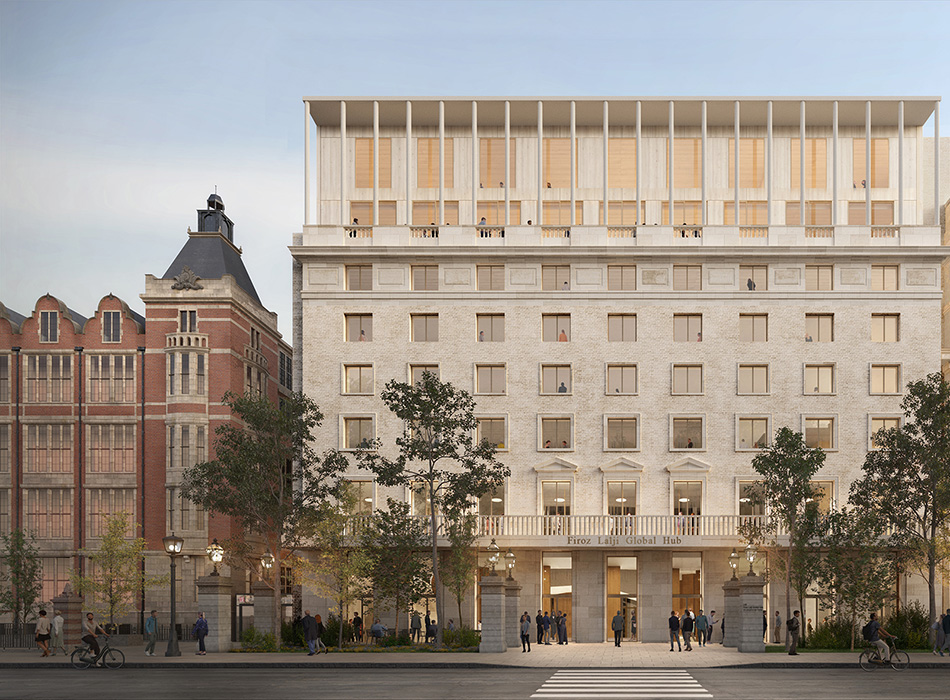London-based practice David Chipperfield Architects with Feix and Merlin have been selected as the winners of the competition to design 35 Lincoln’s Inn Fields/the Firoz Lalji Global Hub, the next major building project of the London School of Economics and Political Science (LSE).
The Firoz Lalji Hub will house the Firoz Lalji Africa Institute, Executive Education, the Departments of Mathematics, Statistics and Methodology, the Data Science Institute and conference facilities that will help to connect and engage LSE’s global community. Over 100 responses were received from architectural practices across the world, and six architectural teams were shortlisted for the School’s fourth RIBA design competition. In alphabetical order, the six teams were:
- Alison Brooks with Studio Contra (Nigeria)
- David Chipperfield with Feix and Merlin
- Dorte Mandrup (DNK) and John Robertson Architects
- Feilden Clegg Bradley with Lendager (DNK)
- Hall McKnight
- John McAslan + Partners with Tod Williams/Billie Tsien Architects (US) and Marina Tabassum (Bangladesh)
The task of selecting the winning team for this +£100m project fell to an LSE jury panel comprising Baroness Minouche Shafik (Director of LSE, Chair), Firoz Lalji (LSE alumnus and donor), Sir David Higgins (Chair of LSE Finance and Estates Committee), Julian Robinson (Director of Estates), Professor Ricky Burdett CBE, Professor Pauline Barrieu (Chair of Academic Board), Josie Stephens and Tilly Mason (LSE Students’ Union General Secretaries) and Shelley McNamara Grafton Architects).
Dame Minouche Shafik, Director of LSE, chaired the Jury Panel which made the final decision after presentations from the six shortlisted teams. She commented: “We had a difficult decision to make as the quality of the submissions proved to be extremely strong, but I’m pleased to announce David Chipperfield Architects with Feix and Merlin as the winner of our design competition for The Firoz Lalji Global Hub. This sustainable design solution follows the ethos of LSE, taking an existing building and adapting it for the 21st century. I have no doubt it will further enhance LSE’s status as a university with a world-class estate that matches its global academic reputation.”
Julian Robinson, Director of Estates and Jury Panel Member said: “This was our toughest competition yet! A multi-faceted brief and a requirement to deliver the School’s first net zero carbon building was a challenge for both the competing teams and LSE. As our last set piece project, it was essential we took time to get this decision right. We appreciate the enormous amount of intellectual creativity and effort expended by the competitors, but we could only select one winner. We believe David Chipperfield’s design was the most sustainable solution that achieved our brief requirements and provides LSE with a seminal piece of university architecture. It’s an inspiring design and I look forward to working with David Chipperfield and his team to deliver another outstanding project for the School.”
David Chipperfield said: "We are delighted to have been selected by LSE to design the new Firoz Lalji Global Hub. We have embraced the ethos and mission of the new centre to address global issues through our strategy of adaptive reuse. Our project demonstrates how the reuse of existing buildings can be seen not as an obligation but as a commitment to a more resourceful and responsible approach to our future, based on intelligent use of existing material and cultural capital. We believe that the cultural and educational ambitions of the Firoz Lalji Global Hub are reflected in the design process itself the highly coordinated engagement of the team, client and context."
Firoz Lalji, an LSE alumnus and major benefactor to the School, and his family have recently contributed $35million for the creation of the Firoz Lalji Global Hub. Firoz commented: “The whole process has been amazing, involving intense debate and the analytical rigour you’d expect from LSE. The journey has only just begun and my family and I are excited to be part of creating a building of lasting impact – both physically and academically – which will enhance further LSE’s reputation as a world leader in the social sciences.”
Previous winners of LSE Design competitions include: Grimshaw, O’Donnell +Tuomey, RHSP and Grafton Architects.







